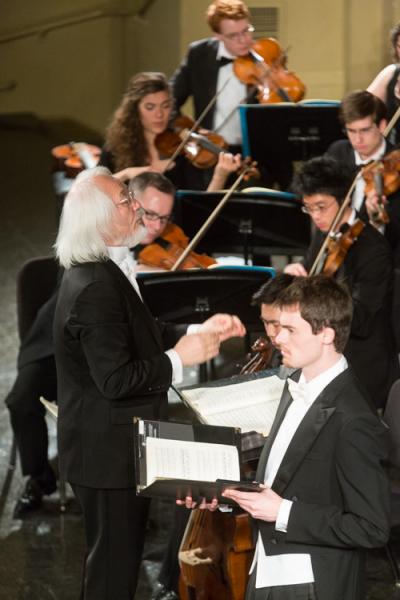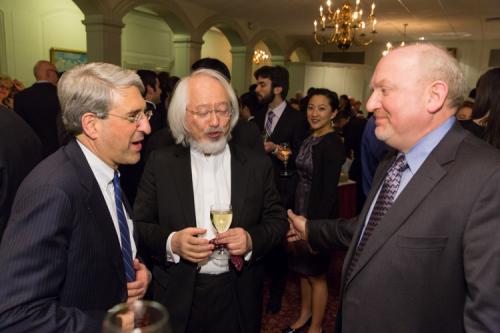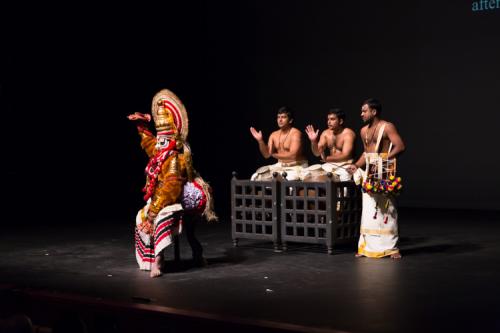by Martin D. Jean
As we complete this “end of the year issue” of Prism, already we are anticipating the arrival of our new class. Our exhilarating study trip to Italy is a distant memory, and the celebrations of our 40th anniversary now spur us on to ponder the future.
Before turning the final page on last year, allow me to reflect further on the occasion of our 40th anniversary. As it happened, in many ways, the year was business as usual. We began with a terrific intake of another talented class of new students, and we witnessed profound intellectual and artistic growth throughout the entire student body. You can read about some of their extraordinary achievements elsewhere in this issue. Our public events series began with a community hymn festival in Woolsey Hall featuring commentary by Thomas Troeger, and led by Marguerite Brooks with Camerata, and John Ferguson at the organ.
Our faculty went from strength to strength. As you know, we were joined this year by two new colleagues, David Hill and Christian Wiman, each of whom has enriched our interdisciplinary life in so many ways. Our other faculty, in addition to their teaching and scholarship, were on the road in a variety of places, and both Melanie Ross and Vasileios Marinis have been awarded prestigious research fellowships that will support their sabbaticals next year, which you can read about in Faculty News.
While we marked our anniversary throughout the year on numerous occasions, our efforts were particularly concentrated in April, which featured a lecture and reading by the author Fanny Howe, an exhibition by the renowned Greek iconographer George Kordis, another on sacred art of southeast Asia, a spectacular performance of Honegger’s King David by Marguerite L. Brooks and the Camerata, an international symposium on Byzantine liturgy and art, and then of course, the events on our gala weekend in early April – all of which you read about in the last issue

During the weekend of April 4 – 6, Yale Schola Cantorum joined forces with Yale Baroque Ensemble and Juilliard415 under the baton of Masaaki Suzuki to perform Bach’s St. John Passion at Alice Tully Hall and Woolsey Hall on consecutive nights. There were many unforgettable moments in these performances: the bitterness of the opening chorus, the sardonic character of “Lasset uns den nicht zerteilen”, the pounding rhythm of “Kreuzige”, and the theologically profound “Es ist vollbracht.” All of our students sang and played well beyond their years: of particular note were the performances of our Evangelist, Kyle Stegall, whose very first appearance in the role was on the prestigious Lincoln Center stage.
At the reception after the New Haven performance people gave gratifying testimony to the work of the ISM (some of which are included in this issue). In addition, I was particularly touched by Masaaki Suzuki’s drawing a connection in his own life to his first organ teacher, Mr. Minoru Yoshida, who was a graduate of the Union School of Sacred Music (as was his teacher before him, Mr. Kouten Okuda). I was also deeply moved by the words of Yale’s new president, Peter Salovey, as he acknowledged that his vision of a “more integrated Yale” had already been realized by the ISM – for the last four decades!

The other major event of this festive weekend occurred on the Sunday, with the presentation of an ancient sacred Sanskrit play by the Nepathya Theatre Troupe from Kerala, India. In collaboration with the Yale Department of Religious Studies, with support from the Lex Hixon Fund and the South Asian Studies Council, and under the guidance of Prof. Phyllis Granoff (Yale) and Prof. David Shulman (Hebrew University), the ISM staged an abbreviated performance of the Kudiyattam work The Death of Bali. This rarely performed theatrical form is considered by the United Nations Educational, Scientific, and Cultural Organization (UNESCO) as a “masterpiece of the oral and intangible heritage of humanity.”

It would be difficult to imagine two artistic masterworks more different in terms of the countries and cultures and worldviews that gave rise to them. Even so, I was struck more by the commonalities shared by the St. John Passion and The Death of Bali. Both are narratives about a deity who becomes embroiled in the evil of the world, and, arguably, appears even to cause the evil (though many would assert it is for the sake of the good). Time unfolds very slowly in both works: each is a series of tableaux in which considerable time is given to developing the simplest word or idea. In both cases, musical gestures are communicated in very stylized way, using a kind of cantillation, and both forms use spellbinding beauty to engage the audience: the gorgeous orchestration and melodies in the Bach, and the lavish costumes and makeup in the Kudiyattam. Finally, for the performers, both of these sophisticated art forms require a lifetime of preparation. I was particularly touched that each set of performers attended the others’ event – for all of them it was a first foray into a new and wildly different cultural world.
Our 2013-2014 performance series concluded with a sterling performance by Schola of Haydn’s Harmony Mass, led by David Hill, and our academic program ended with our study trip to Italy, about which you can read in this issue.
With our yearlong celebration behind us, I am filled with gratitude for the many people who contributed to what the Institute is today: for our founding faculty and staff; for directors Baker, Bailey, Cook, and Fassler; for four decades of students who not only learn from us, but teach us as well; for generations of Yale administrators who have cared for this precious bequest and who ensure it is used according to donor intent; for the collaboration and support of the deans and faculty of the School of Music and Divinity School; for our eminently able staff who have supported the work of the Institute all these years; and for the world renowned ISM faculty, past and present, without whom there would be no ISM. Finally, we all give thanks to Mrs. Tangeman and Mr. Miller and their families who saw the inherent value in sacred music, worship, and the arts, as a means to communicate the innermost convictions of communities of faith, and as tools to heal a wounded and embattled world.
For all these blessings of the past and all the opportunities that lie ahead, thanks be to God.